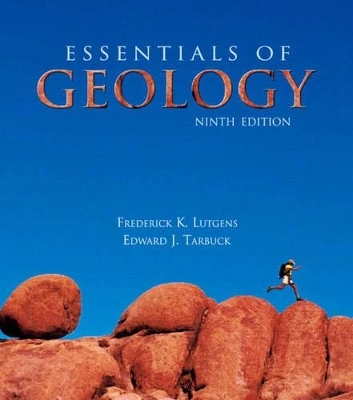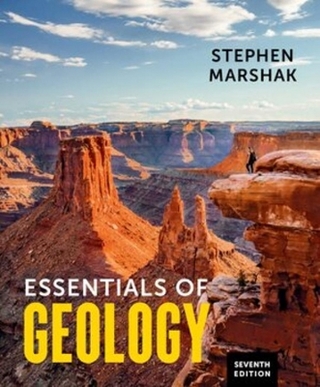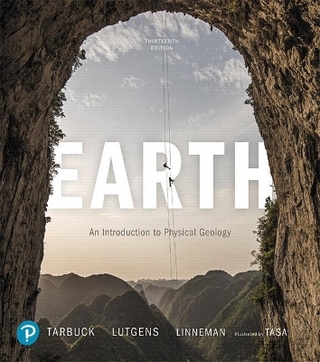
Essentials of Geology
Pearson
978-0-13-149749-8 (ISBN)
- Titel erscheint in neuer Auflage
- Artikel merken
This ninth edition of Essentials of Geology offers completely updated material and an extensively revised design, yet retains the hallmarks instructors have come to expect from Lutgens and Tarbuck — a student-friendly writing style, outstanding illustrations by Dennis Tasa that are both geologically accurate and visually appealing, and updated coverage of the most recent geologic events.
Chapter 1
An Introduction to Geology
The Science of Geology
Geology, People, and the Environment
Historical Notes About Geology
Catastrophism
The Birth of Modern Geology
Geologic Time
The Nature of Scientific Inquiry
Hypothesis
Theory
Scientific Methods
Earth’s Spheres
Hydrosphere
Atmosphere
Biosphere
Geosphere
Earth as a System
Earth System Science
The Earth System
The Rock Cycle: One of Earth’s Subsystems
The Basic Cycle
Alternative Paths
Earth’s Internal Structure
Layers Defined by Composition
Early Evolution of Earth
Origin of Planet Earth
Formation of Earth’s Layered Structure
Layers Defined by Physical Properties
The Face of Earth
Features of the Continents
Features of the Ocean Basins
Dynamic Earth
The Theory of Plate Tectonics
Plate Boundaries
Box 1.1 Do Glaciers Move? An Application of the Scientific Method
Chapter 2
Minerals: Building Blocks of Rocks
Minerals: Building Blocks of Rocks
Elements: Building Blocks of Minerals
Why Atoms Bond
Ionic Bonds: Electrons Transferred
Covalent Bonds: Electrons Shared
Other Bonds
Isotopes and Radioactive Decay
Properties of Minerals
Primary Diagnostic Properties
Other Properties of Minerals
Mineral Groups
The Silicates
The Silicon—Oxygen Tetrahedron
Other Silicate Structures
Joining Silicate Structures
Common Silicate Minerals
The Light Silicates
The Dark Silicates
Important Nonsilicate Minerals
Mineral Resources
Box 2.1 Asbestos: What Are the Risks?
Chapter 3
Igneous Rocks
Magma: The Parent Material of Igneous Rock
The Nature of Magma
From Magma to Crystalline Rock
Igneous Textures
Factors Affecting Crystal Size
Types of Igneous Textures
Igneous Compositions
Granitic versus Basaltic Compositions
Other Compositional Groups
Silica Content as an Indicator of Composition
Naming Igneous Rocks
Felsic (Granitic) Igneous Rocks
Intermediate (Andesitic) Igneous Rocks
Mafic (Basaltic) Igneous Rocks
Pyroclastic Rocks
Origin of Magma
Generating Magma from Solid Rock
How Magmas Evolve
Bowen’s Reaction Series and the Composition of Igneous Rocks
Assimilation and Magma Mixing
Partial Melting and Magma Formation
Mineral Resources and Igneous Processes
Box 3.1 A Closer Look at Bowen’s Reaction Series
Chapter 4
Volcanoes and Other Igneous Activity
The Nature of Volcanic Eruptions
Factors Affecting Viscosity
Importance of Dissolved Gases
Materials Extruded During an Eruption
Lava Flows
Gases
Pyroclastic Materials
Volcanic Structures and Eruptive Styles
Anatomy of a Volcano
Shield Volcanoes
Cinder Cones
Composite Cones
Living in the Shadow of a Composite Cone
Eruption of Vesuvius a.d. 79
Nuée Ardente: A Deadly Pyroclastic Flow
Lahars: Mudflows on Active and Inactive Cones
Other Volcanic Landforms
Calderas
Fissure Eruptions and Basalt Plateaus
Volcanic Pipes and Necks
Intrusive Igneous Activity
Nature of Plutons
Diles
Sills and Laccoliths
Batholiths
Plate Tectonics and Igneous Activity
Igneous Activity at Convergent Plate Boundaries
Igneous Activity at Divergent Plate Boundaries
Intraplate Igneous Activity
Box 4.1 Anatomy of an Eruption
Box 4.2 Can Volcanoes Change Earth’s Climate?
Chapter 5
Weathering and Soils
Earth’s External Processes
Weathering
Mechanical Weathering
Frost Wedging
Unloading
Biological Activity
Chemical Weathering
Water and Carbonic Acid
How Granite Weathers
Weathering of Silicate Minerals
Spheroidal Weathering
Rates of Weathering
Rock Characteristics
Climate
Differential Weathering
Soil
An Interface in the Earth System
What Is Soil?
Controls of Soil Formation
Parent Material
Time
Climate
Plants and Animals
Topography
The Soil Profile
Soil Erosion
How Soil Is Eroded
Classifying Soils
Rates of Erosion
Sedimentation and Chemical Pollution
Weathering: The Cause of Ore Deposits
Bauxite
Other Deposits
Box 5.1 Clearing the Tropical Rain ForestThe Impact on Its Soils
Chapter 6
Sedimentary Rocks
What Is a Sedimentary Rock?
Turning Sediment into Sedimentary Rock: Diagenesis and Lithification
Types of Sedimentary Rocks
Detrital Sedimentary Rocks
Shale
Sandstone
Conglomerate and Breccia
Chemical Sedimentary Rocks
Limestone
Dolostone
Chert
Evaporites
Coal
Classification of Sedimentary Rocks
Sedimentary Rocks Represent Past Environments
Sedimentary Structures
Nonmetallic Mineral Resources from Sedimentary Rocks
Energy Resources from Sedimentary Rocks
Coal
Oil and Natural Gas
Box 6.1: The Carbon Cycle and Sedimentary Rocks
Chapter 7
Metamorphic Rocks
Metamorphism
Agents of Metamorphism
Heat as a Metamorphic Agent
Pressure and Differential Stress
Chemically Active Fluids
Metamorphic Textures
Foliation
Foliated Textures
Other Metamorphic Textures
Common Metamorphic Rocks
Foliated Rocks
Nonfoliated Rocks
Metamorphic Environments
Contact or Thermal Metamorphism
Hydrothermal Metamorphism
Regional Metamorphism
Other Metamorphic Environments
Metamorphic Zones
Textural Variations
Index Minerals and Metamorphic Grade
Chapter 8
Mass Wasting: The Work of Gravity
A Landslide Disaster in Peru
Mass Wasting and Landform Development
The Role of Mass Wasting
Slopes Change Through Time
Controls and Triggers of Mass Wasting
The Role of Water
Oversteepened Slopes
Removal of Vegetation
Earthquakes as Triggers
Landslides Without Triggers?
Classification of Mass-Wasting Processes
Type of Material
Type of Motion
Rate of Movement
Slump
Rockslide
Debris Flow
Debris Flows in Semiarid Regions
Lahars
Earthflow
Slow Movements
Creep
Solifluction
Box 8.1: Debris Flows on Alluvial Fans: A Case Study from Venezuela
Box 8.2: The Sensitive Permafrost Landscape
Chapter 9
Running Water
Earth as a System: The Hydrologic Cycle
Running Water
Drainage Basins
River Systems
Streamflow
Gradient and Channel Characteristics
Discharge
Changes from Upstream to Downstream
The Work of Running Water
Erosion
Transportation
Deposition
Stream Channels
Bedrock Channels
Alluvial Channels
Base Level and Stream Erosion
Shaping Stream Valleys
Valley Deepening
Valley Widening
Changing Base Level and Incised Meanders
Depositional Landforms
Deltas
Natural Levees
Alluvial Fans
Drainage Patterns
Floods and Flood Control
Causes and Types of Floods
Flood Control
Box 9.1: Coastal Wetlands Are Vanishing on the Mississippi Delta
Chapter 10
Groundwater
Importance of Underground Water
Distribution of Underground Water
The Water Table
Variations in the Water Table
Interaction Between Groundwater and Streams
Factors Influencing the Storage and Movement of Groundwater
Porosity
Permeability, Aquitards, and Aquifers
How Groundwater Moves
Springs
Wells
Artesian Wells
Environmental Problems Associated with Groundwater
Treating Groundwater as a Nonrenewable Resource
Land Subsidence Caused by Groundwater Withdrawal
Groundwater Contamination
Hot Springs and Geysers
Geothermal Energy
The Geologic Work of Groundwater
Caverns
Karst Topography
Box 10.1 Measuring Groundwater Movement
Box 10.2: The Case of the Disappearing Lake
Chapter 11
Glaciers and Glaciation
Glaciers: A Part of Two Basic Cycles
Valley (Alpine) Glaciers
Other Types of Glaciers
How Glaciers Move
Rates of Glacial Movement
Budget of a Glacier
Glacial Erosion
Landforms Created by Glacial Erosion
Glaciated Valleys
Arêtes and Horns
Roches Moutonnées
Glacial Deposits
Types of Glacial Drift
Moraines, Outwash Plains, and Kettles
Drumlins, Eskers, and Kames
Glaciers of the Ice Age
Some Indirect Effects of Ice Age Glaciers
Causes of Glaciation
Plate Tectonics
Variations in Earth’s Orbit
Other Factors
Box 11.1 The Collapse of Antarctic Ice Shelves
Box 11.2 Glacial IceA Storehouse of Climate Data
Chapter 12
Deserts and Wind
Distribution and Causes of Dry Lands
Low-Latitude Deserts
Middle-Latitude Deserts
Geologic Processes in Arid Climates
Weathering
The Role of Water
Basin and Range: The Evolution of a Desert Mountainous Landscape
Transportation of Sediment by Wind
Bed Load
Suspended Load
Wind Erosion
Deflation, Blowouts, and Desert Pavement
Wind Abrasion
Wind Deposits
Sand Deposits
Types of Sand Dunes
Loess (Silt) Deposits
Box 12.1 The Disappearing Aral Sea
Box 12.2 Dust BowlSoil Erosion in the Great Plains
Chapter 13
Shorelines
The Shoreline: A Dynamic Interface
The Coastal Zone
Waves
Wave Characteristics
Circular Orbital Motion
Waves in the Surf Zone
Wave Erosion
Sand Movement on the Beach
Movement Perpendicular to the Shoreline
Wave Refraction
Beach Drift and Longshore Currents
Shoreline Features
Erosional Features
Depositional Features
The Evolving Shore
Stabilizing the Shore
Hard Stabilization
Alternatives to Hard Stabilization
Erosion Problems Along U.S. Coasts
Coastal Classification
Emergent Coasts
Submergent Coasts
Tides
Causes of Tides
Monthly Tidal Cycle
Tidal Currents
Box 13.1 The Move of the CenturyRelocating the Cape Hatteras Lighthouse
Box 13.2 Coastal Vulnerability to Sea-Level Rise
Chapter 14
Earthquakes and Earth’s Interior
What Is an Earthquake?
Earthquakes and Faults
Discovering the Cause of Earthquakes
Foreshocks and Aftershocks
San Andreas Fault: An Active Earthquake Zone
Seismology: The Study of Earthquake Waves
Locating an Earthquake
Measuring the Size of Earthquakes
Intensity Scales
Magnitude Scales
Destruction from Earthquakes
Destruction from Seismic Vibrations
Tsunami
Landslides and Ground Subsidence
Fire
Can Earthquakes Be Predicted?
Short-Range Predictions
Long-Range Forecasts
Earthquake’s and Earth’s Interior
Layers Defined by Composition
Layers Defined by Physical Properties
Discovering Earth’s Major Layers
Discovering Earth’s Composition
Box 14.1 Damaging Earthquakes East of the Rockies
Chapter 15
Plate Tectonics: A Scientific Theory Unfolds
Continental Drift: An Idea Before Its Time
Evidence: The Continental Jigsaw Puzzle
Evidence: Fossils Match Across the Seas
Evidence: Rock Types and Structures Match
Evidence: Ancient Climates
The Great Debate
Plate Tectonics: The New Paradigm
Earth’s Major Plates
Plate Boundaries
Divergent Boundaries
Oceanic Ridges and Seafloor Spreading
Continental Rifting
Convergent Boundaries
Oceanic—Continental Convergence
Oceanic-Oceanic Convergence
Continental—Continental Convergence
Transform Fault Boundaries
Testing the Plate Tectonics Model
Evidence: Ocean Drilling
Evidence: Hot Spots
Evidence: Paleomagnetism
Measuring Plate Motion
What Drives Plate Motion?
Forces that Drive Plate Motion
Models of Plate-Mantle Convection
Plate Tectonics into the Future
Box 15.1 The Breakup of Pangaea
Chapter 16
Origin and Evolution of the Ocean Floor
An Emerging Picture of the Ocean Floor
Mapping the Seafloor
Viewing the Ocean Floor from Space
Provinces of the Ocean Floor
Continental Margins
Passive Continental Margins
Active Continental Margins
Features of Deep-Ocean Basins
Deep-Ocean Trenches
Abyssal Plains
Seamounts, Guyots, and Oceanic Plateaus
Anatomy of the Oceanic Ridge
Origin of Oceanic Lithosphere
Seafloor Spreading
Why Are Oceanic Ridges Elevated?
Spreading Rates and Ridge Topography
The Structure of Oceanic Crust
Formation of Oceanic Crust
Interactions Between Seawater and Oceanic Crust
Continental Rifting: The Birth of a New Ocean Basin
Evolution of an Ocean Basin
Destruction of Oceanic Lithosphere
Why Oceanic Lithosphere Subducts
Subducting Plates: The Demise of an Ocean Basin
Opening and Closing Ocean Basins: The Supercontinent Cycle
Before Pangaea
Box 16.1 Explaining Coral AtollsDarwin’s Hypothesis
Chapter 17
Crustal Deformation and Mountain Building
Rock Deformation
Temperature and Confining Pressure
Rock Type
Time
Folds
Types of Folds
Domes and Basins
Faults
Dip-Slip Faults
Strike-Slip Faults
Joints
Mountain Building at Subduction Zones
Island Arcs
Mountain Building Along Andean-Type Margins
Mountain Building
Collisional Mountain Ranges
Terranes and Mountain Building
Continental Collisions
Fault-Block Mountains
Vertical Movements of the Crust
Isostasy
How High Is Too High?
Box 17.1 The San Andreas Fault System
Chapter 18
Geologic Time
Geology Needs a Time Scale
Relative DatingKey Principles
Law of Superposition
Principle of Original Horizontality
Principle of Cross-Cutting Relationships
Inclusions
Unconformities
Using Relative Dating Principles
Correlation of Rock Layers
Fossils: Evidence of Past Life
Types of Fossils
Conditions Favoring Preservation
Fossils and Correlation
Dating with Radioactivity
Reviewing Basic Atomic Structure
Radioactivity
Half-Life
Radiometric Dating
Dating with Carbon-14
Importance of Radiometric Dating
The Geologic Time Scale
Structure of the Time Scale
Precambrian Time
Difficulties in Dating the Geologic Time Scale
Box 18.1 Radon
Box 18.2 Using Tree Rings to Date and Study the Recent Past
Chapter 19
Earth History: A Brief Summary
Early Evolution of Earth
Earth’s Primitive Atmosphere
Earth’s Atmosphere Evolves
Precambrian Time: Vast and Enigmatic
Precambrian History
Precambrian Fossils
Paleozoic Era: Life Explodes
Paleozoic History
Early Paleozoic Life
Late Paleozoic Life
Mesozoic Era: Age of the Dinosaurs
Mesozoic History
Mesozoic Life
Cenozoic Era: Age of Mammals
Cenozoic North America
Cenozoic Life
Box 19.1 Demise of the Dinosaurs
| Erscheint lt. Verlag | 22.8.2005 |
|---|---|
| Sprache | englisch |
| Maße | 102 x 102 mm |
| Gewicht | 1190 g |
| Themenwelt | Naturwissenschaften ► Geowissenschaften ► Geologie |
| ISBN-10 | 0-13-149749-9 / 0131497499 |
| ISBN-13 | 978-0-13-149749-8 / 9780131497498 |
| Zustand | Neuware |
| Haben Sie eine Frage zum Produkt? |
aus dem Bereich



